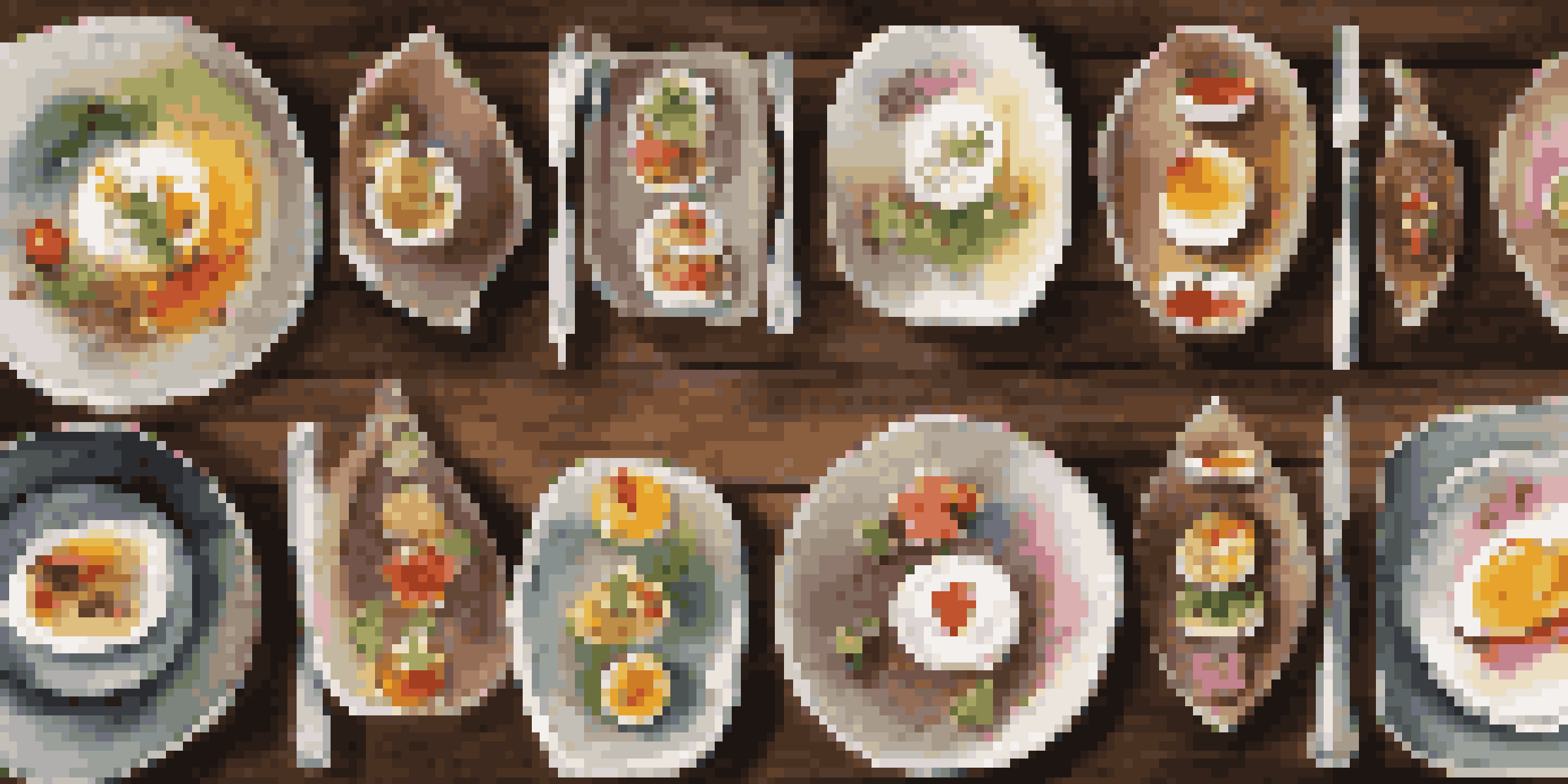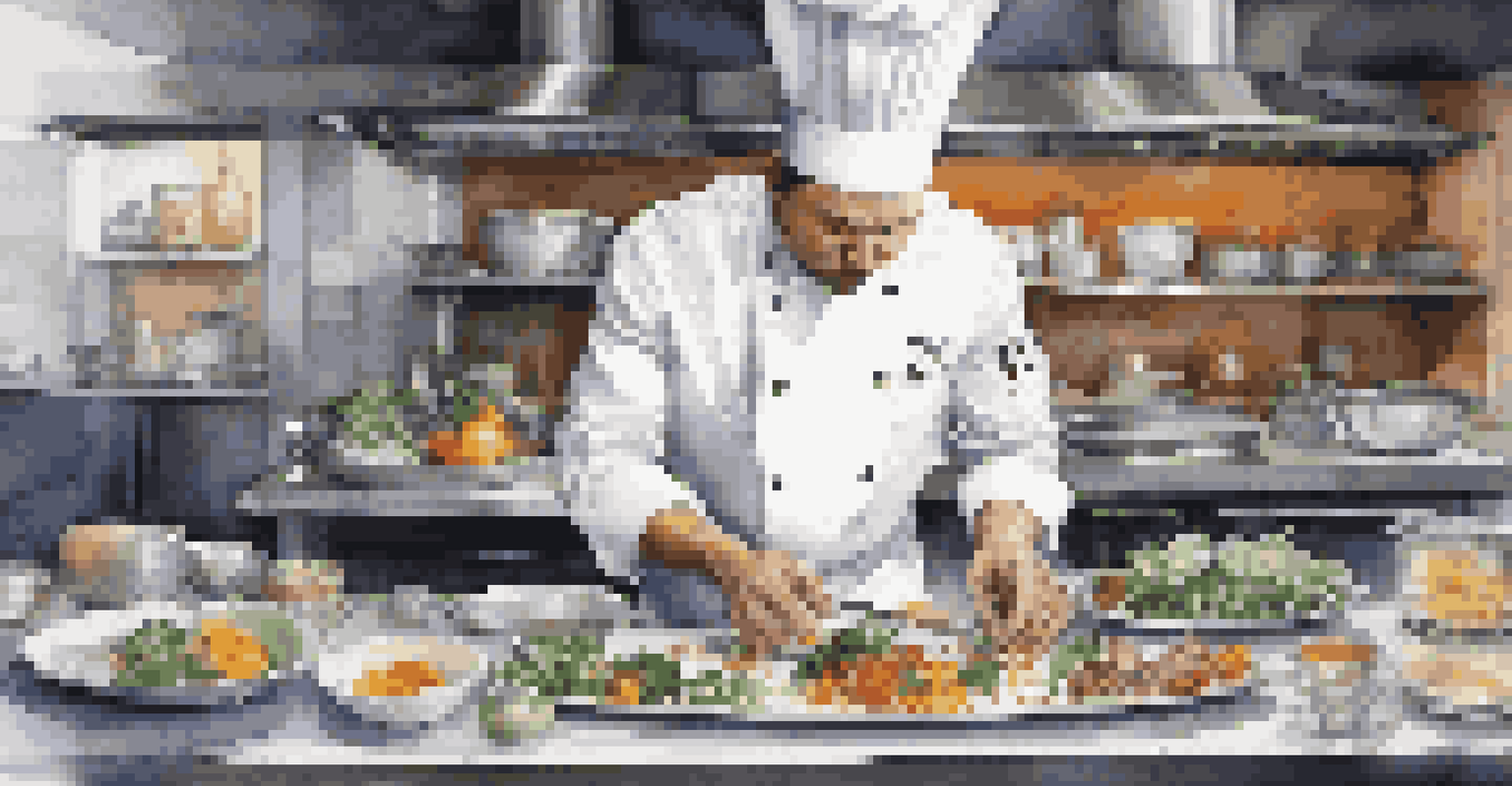The Evolution of Tasting Menus: A Culinary Journey

Tracing the Origins of Tasting Menus in Fine Dining
Tasting menus have a storied history, often linked to the lavish banquets of royalty. These elaborate meals offered a variety of dishes, allowing guests to sample different flavors and culinary techniques. Over time, this concept evolved, moving from grand feasts to more refined dining experiences in upscale restaurants.
Cooking is like love. It should be entered into with abandon or not at all.
In the late 19th and early 20th centuries, chefs began to craft tasting menus as a way to showcase their skills and creativity. This shift marked the beginning of a new culinary era, where the focus was on artistry and innovation rather than mere sustenance. Chefs like Auguste Escoffier paved the way by introducing multi-course meals that highlighted seasonal ingredients.
As we progressed into the late 20th century, tasting menus became synonymous with fine dining establishments. Diners were no longer just eating; they were embarking on a gastronomic adventure, savoring each carefully curated course that told a story through flavor and presentation.
The Rise of the Modern Tasting Menu Experience
The late 1990s and early 2000s saw a surge in popularity for tasting menus, with chefs seeking to push culinary boundaries. This period was characterized by unique flavor combinations and innovative techniques, transforming the dining experience into a theatrical affair. Restaurants began to embrace an artistic approach, presenting food as both a visual and emotional experience.

Renowned chefs like Thomas Keller and Ferran Adrià popularized the concept of a multi-course tasting menu, encouraging diners to explore unexpected flavors and textures. This movement not only delighted the senses but also invited guests to appreciate the craftsmanship behind each dish. Diners found themselves immersed in the chef's vision, making the meal a personal and memorable journey.
Tasting Menus Evolved from Royal Feasts
Originally linked to lavish banquets, tasting menus transformed into a showcase of culinary artistry in fine dining.
Moreover, tasting menus became a way for chefs to adapt to seasonal and local ingredients, emphasizing sustainability. This shift not only supported local farmers but also allowed diners to experience the essence of their region through a thoughtfully curated meal.
Diversity in Tasting Menus: Global Influences
As culinary techniques and traditions spread across the globe, tasting menus began to reflect diverse cultural influences. Chefs started incorporating elements from various cuisines, creating unique fusions that tantalized palates. For instance, the introduction of Asian flavors in Western tasting menus opened up new avenues for creativity and experimentation.
The chef’s job is to make the world a better place, one meal at a time.
This blending of culinary traditions has led to the emergence of various tasting styles, from traditional French to avant-garde molecular gastronomy. Diners can now experience a wide range of flavors, textures, and presentations in a single meal, making each tasting menu an exciting exploration of global gastronomy.
Additionally, the rise of food tourism has fueled interest in tasting menus, as travelers seek authentic experiences. Dishes that reflect local culture and ingredients not only satisfy hunger but also tell a story about the place and people behind the meal.
The Influence of Technology on Tasting Menus
In recent years, technology has significantly influenced the evolution of tasting menus. From innovative cooking techniques to advanced food presentation tools, chefs are now equipped to push the boundaries of culinary art. Techniques like sous-vide cooking and 3D food printing have opened up new possibilities, allowing for flavors and presentations that were once unimaginable.
Moreover, social media has transformed the way diners experience tasting menus. The visual appeal of dishes is now more important than ever, as chefs create stunning presentations that are Instagram-worthy. This emphasis on aesthetics not only enhances the dining experience but also encourages diners to share their meals, further promoting the restaurant's brand.
Modern Menus Embrace Personalization
Today's tasting menus often feature personalized experiences, allowing chefs to create dishes tailored to individual diners' preferences.
As diners become more tech-savvy, restaurants are also adopting digital menus and storytelling elements that enhance the tasting experience. Interactive elements, such as pairing wines with courses through apps, allow guests to engage with their meal in a more profound way.
Sustainability and Ethical Sourcing in Tasting Menus
Today’s diners are increasingly concerned about the origins of their food, prompting a shift towards sustainability in tasting menus. Chefs are now prioritizing ethically sourced ingredients, often highlighting local farmers and organic produce. This not only assures diners of quality but also supports the sustainability movement within the culinary industry.
By incorporating seasonal and local ingredients, tasting menus can showcase the best flavors of a region while minimizing the carbon footprint associated with food transportation. This approach allows chefs to create dishes that are not only delicious but also environmentally conscious.
In this evolving culinary landscape, diners are also becoming more aware of their food choices. The inclusion of plant-based options in tasting menus caters to a broader audience, ensuring that everyone can enjoy a gourmet experience while aligning with their values.
The Role of Personalization in Tasting Menus
Personalization has become a key trend in the world of tasting menus, as chefs look to tailor experiences to individual diners. Whether it’s accommodating dietary restrictions or preferences, restaurants are increasingly focused on creating a bespoke culinary journey for each guest. This level of attention not only enhances the dining experience but also fosters a deeper connection between diners and chefs.
Some establishments even invite guests to communicate their flavor profiles or favorite ingredients, allowing chefs to craft unique dishes that resonate with each individual. This personalized approach transforms a standard meal into a memorable event, as diners see their preferences reflected in the dishes served.
Sustainability Shapes Modern Dining
Increasingly, chefs prioritize ethically sourced and local ingredients, reflecting diners' growing concerns about sustainability.
Furthermore, this trend is supported by the growing inclination towards experiential dining, where the meal becomes a narrative. Chefs now curate tasting menus that tell a story, engaging all senses and creating lasting memories for their guests.
The Future of Tasting Menus: Trends to Watch
As we look to the future, several trends are poised to shape the evolution of tasting menus. One of the most significant is the focus on immersive dining experiences, where the meal goes beyond just food. Concepts like themed dinners and interactive cooking demonstrations are gaining traction, creating a multi-sensory experience that captivates diners.
Additionally, as technology continues to evolve, we can expect even more innovative culinary techniques to emerge. Virtual reality dining experiences or augmented reality menus might soon become commonplace, allowing guests to engage with their food in entirely new ways.

Lastly, with the ongoing conversation around health and wellness, we may see a rise in tasting menus that focus on nutrition and functional ingredients. Diners are increasingly interested in food that not only tastes good but also supports their well-being, which could lead to a new wave of culinary creativity.